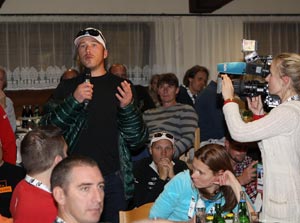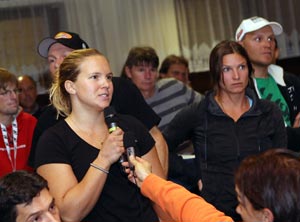Athletes publicly challenge FIS ski changes at opening World Cup meeting
 SOELDEN, Austria — Nothing really happened, but a lot was said.
SOELDEN, Austria — Nothing really happened, but a lot was said.
Just 20 hours before the start of the World Cup season, the world’s best racers met with International Ski Federation (FIS) officials today (Oct. 21) to discuss unprecedented changes announced this summer by the FIS to change the rules regarding the dimensions of skis.
The two and a half hour meeting opened with Men’s World Cup race director Gunter Hujara telling the crowded room of over 400 athletes, officials, medical experts and members of the media about the goals facing the team of scientists who carried out experiments to determine how to reduce injures in the sport.
“The goal and aim was to reduce injures, not to change the feeling or look of skiing, it’s very important to remember that,” said Hujara, who has been at the helm of the men’s World Cup tour for more than 20 years.
The changes to men’s giant slalom skis, a radius change from 27 meters to 35 meters, has received the most criticism since the July 21 announcement. The new rules are set to go into force at the onset of the 2012-2013 season, a year from now.
Following Hujara’s comments, the audience was shown dozens of charts and graphs representing the data collected by both a six year-long study called the Injury Surveillance System and the findings of a Risk Factor Analysis conducted by Professor Erich Muller of the University of Salzburg during the 2010 season. Muller and his team interviewed 63 athletes, coaches and industry experts with the focus of reducing speed and “decreasing the self steering behavior of equipment.” Muller admitted that several other “injury driving factors” were not thoroughly investigated due to financial and manufacturing limitations.
Obviously frustrated following a lengthy presentation of dense, scientific data, American Bode Miller initiated the questions from the large group of athletes. Miller questioned why FIS didn’t look at the regulations of bindings before the dimensions of skis. Miller also called for a review of video footage from the 90’s when skis matching the new regulations were used.
“One thing that I have been frustrated with over the last few years is that we haven’t been allowed to progress as athletes. We’re concerned with our safety and the progression of the sport is what allows us to adapt,” said Miller. “We will progress forward on our own to avoid injury, as apposed to what you’re suggestion, which is to digress backwards in the opposite direction. I really think that if the restrictions were all removed entirely, there would be a huge move, a technical evolution where the skis would change, the bindings would change, the boots would change and all these young athletes would who grew up skiing on shape skis would be able to use their innovation and their ideas to develop the sport.”
“We cannot attack everything at the same time,” responded Hujara, who later in the meeting presented examples of new suits designed to be slower and safer as well as introducing a new regulation requiring helmets used in downhill and super G races to meet standards marked by a special sticker.
“It’s also important for us in the sport that it doesn’t become lame,” continued Miller. “If you can go into a store and buy a better ski than we can race on the World Cup, it’s going to create a whole new set of problems for the sport.”
 Reigning overall downhill and super G champion, Swiss veteran Didier Cuche joined Miller as a vocal leader of the athletes. Cuche asked all athletes in attendance to stand. The standing wall of opposition to the new changes remained on the other side of the room from FIS officials and appointed experts throughout the last hour of the meeting, repeatedly questioning the methods and motivations of the research and decision making.
Reigning overall downhill and super G champion, Swiss veteran Didier Cuche joined Miller as a vocal leader of the athletes. Cuche asked all athletes in attendance to stand. The standing wall of opposition to the new changes remained on the other side of the room from FIS officials and appointed experts throughout the last hour of the meeting, repeatedly questioning the methods and motivations of the research and decision making.
Cuche also questioned whether the youth of the sport would stay involved when faced with such a drastic change in technique forced by the new ski design. “Will they have fun, will they be attracted to the sport and keep young athletes in the sport,” said Cuche. “It’s definitely not going to be safer for 16-year old skiers.”
Two-time World Cup overall champion Aksel Lund Svindal of Norway also frequently posed questions to FIS leaders during the meeting. “This is all very good on computers and on charts but in reality it’s not working,” he said. “How much are we willing to sacrifice speed and the excitement of the sport for safety.”
After more than two hours of back-and-forth discussion, the meeting came to a dramatic climax when Swedish World Cup star Anja Paerson had six-foot-three-inch Svindal stand next to five-foot-three-inch Swiss standout Lara Gut. “So you are saying that the research done for Aksel is good to use for Lara,” said Paerson after confirming with the researchers that the vast majority of the tests had been conducted with male subjects.
After a long, silent pause while FIS officials played hot potato with the microphone, Paerson answered her own question. “So men are the priority of the World Cup.”
Though rumors have flown recently, no athlete mentioned the idea of a strike. Nor did the FIS show any sign of backing down from the regulations. – Eric Williams
Images by Gepa





















